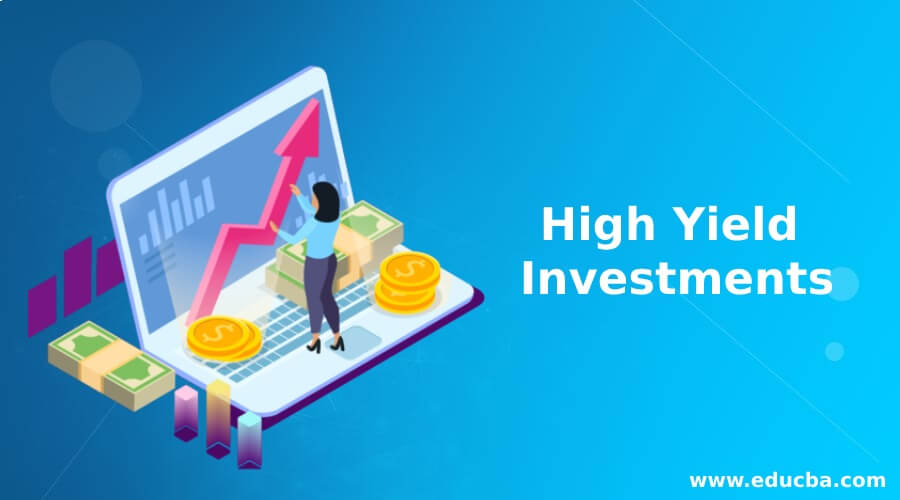Updated July 17, 2023
What are High Yield Investments?
“High-yield investments” refers to instruments offering higher returns in exchange for higher risk. The issuers of such instruments attract investors by offering relatively higher returns than safer investment-grade instruments, given that these investments involve higher risk. Usually, non-investment grade investments are the ones that offer a higher yield and hence are considered high-yield investments.
Explanation
As a thumb rule, if an investment offers a high rate of return within a short period of time, then it means that the investment is risky. Suppose things go according to the investors’ prediction. In that case, these investments can grow multiple times the initial investment amount, which lures most investors to high-yield investments. However, in an adverse scenario, the investors might have to incur huge unattractive losses, which is the risk component.
List of Eight High-Risk Investments
Now, look at some of the major high-risk investment options available.
- Options: Typically, options trading can generate high rewards for investors who can successfully time the market. Investors should be good at understanding the market sentiments and the underlying performances of the stocks. Investors can earn high returns in a short period of time if the price of the underlying securities behaves in the originally predicted way. However, this form of investment is risky as it is highly dependent on the ability of the investors to time the purchase or sale of the securities.
- Initial Public Offerings (IPO): IPOs of less high-profile entities can offer investors the chance to earn high returns by purchasing the shares when they are severely undervalued. The investors can later exit or monetize when a correction in the valuation occurs, resulting in high short and long-term returns. However, IPOs can still be risky because there is always a high degree of uncertainty pertaining to the ability of the company’s management to perform and achieve the desired goal, which is the basis of the company’s valuation.
- Venture Capital: The primary risk around venture capital is that the future of most startups remains unstable and uncertain. The risk is also due to low transparency about the management’s ability to perform the necessary business functions to achieve the desired outcome. While many startups fail, the successful ones can generate returns in multiples of the initial investment.
- Foreign Emerging Markets: A growing or emerging economy is one of the best investment opportunities. Interested investors can purchase either bonds (corporate or government) or stocks, as the country is probably in the middle of hyper-growth. However, the greatest risk in such a market is that nobody can predict how long extreme growth is likely to continue. The political environment in these countries can change rapidly, deteriorating the growth prospects previously seen in the economy.
- Real Estate Investment Trusts (REITs): REITs invest in residential or commercial real estate pools and offer high dividends to investors. Typically, REITs are prone to fluctuations as real estate ventures primarily depend on overall economic developments. The levels of interest rates in REITs oscillate between flourishing and severely depressed. Hence, these investments consider risky.
- High-Yield Bonds: High-yield bonds usually offer extremely high returns to investors in exchange for the potential loss of the entire investment. Many high-yield bonds are considered junk bonds (high probability of default), and investors know that. But investors are particularly attracted by the significantly higher returns compared to the investment-grade bonds offered by the government or reputed corporates.
- Currency Trading: The option of currency trading is best suited to professionals and certainly not for beginners because the currency exchange rate market is fast-paced and can result in significant losses to amateur investors. Investors who can handle the high pressure of currency trading can reduce the risk by understanding the patterns of some of the currencies before putting their money into them.
- High-Risk Mutual Funds: As the name suggests, high-risk mutual funds carry high risk. However, the level of risk can largely reduce by investing in the best-of-the-class high-risk mutual funds, which can deliver higher returns than other mutual funds. So, conducting a proper market study before investing in this type of investment instrument is advisable.
Advantages
Some of the major advantages of high-yield investments are as follows:
- These investments offer higher returns to the investor, increasing their earnings. Despite their weak credit quality, high-yield investments are very popular among investor communities worldwide.
- In some cases, investors can invest in undervalued companies at attractive prices as they are in their initial growth phase. Over the period, the issuer’s credit quality improves, resulting in significant growth in the invested money.
Disadvantages
Some of the major disadvantages of high-yield investments are as follows:
- There is a high probability that the issuer might default, and the investments might become worthless. This risk perception leads to high return requirements.
- In some cases, the investors find it difficult to sell high-yield instruments in the market resulting in liquid risk. Transaction costs, lower frequency as well as volumes of trading contribute to the liquidity risk.
Conclusion
So, it can be seen that high-yield investments involve higher risk and offer higher returns to attract investors. Traders or investors must understand the risk-return trade-off in high-yield investments before they start investing in these instruments. High-yield investments are best suited for investors willing to take the risk.
Recommended Articles
This is a guide to High Yield Investments. Here we also discuss the definition and list of eight high-risk investments along with their advantages and disadvantages. You may also have a look at the following articles to learn more –




